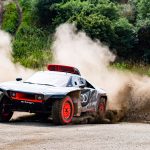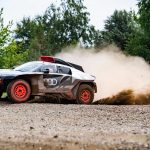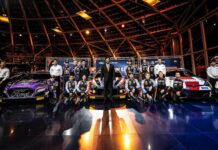Recent reshuffle of the top-level motorsport participation gave the Audi brand one completely fresh challenge for them, conquering the grueling Dakar Rally, and the other also very demanding challenge, their return at the endurance racing and 24 Hours of Le Mans.
As was the case with their first international motorsport activity in rally world with revolutionary “quattro” four wheel drive system, or first race win with hybrid racing car (R18 e-tron) at 24 Hours Le Mans, Audi is coming at the Dakar Rally 2022 aiming to win the race with the first hybrid car that will use alternative drive concept in Dakar Rally.
Markus Duesmann, Chairman of the Board of Management at
AUDI AG:
“A multifaceted commitment to motorsport is and will remain an integral part of
Audi’s strategy, we want to continue demonstrating the brand’s slogan ‘Vorsprung durch
Technik’ in international top-level motorsport in the future and develop innovative
technologies for our road cars. The toughest rally in the world is the perfect stage for
this.”
Technical solutions used to power the Audi RS Q e-tron 4×4 hybrid
Extreme conditions during Dakar Rally will be a perfect test laboratory for further development of Audi famous e-tron technology. The marathon race that lasts two weeks with around 800 km of daily stages presents huge challenge for the inventive and clever Audi engineers.
Audi Dakar Rally car will use an electrified drivetrain in combination with an efficient energy converter.
The ultimate challenge for Audi to win the Dakar Rally using electric drivetrain is met with huge obstacle, there are no charging opportunities in the desert.
And here comes into play engineering art by Audi team, they will synergize all of their motorsport know-how. The innovative charging concept will be highly efficient TFSI combustion engine used by Audi in DTM. It is a part of energy converter that charges the high-voltage battery while driving.
Their calculations are that operated at particularly efficient range between 4.500 and 6.000 rpm, consumption will be below 200 grams per kWh.
The electric drivetrain of the Audi RS Q e-tron is comprised of three identical motor-generator units (MGU’s) used in their current Audi e-tron FE07 Formula E car, developed by Audi Sport for their last season participating in the all-electric open wheel series.
Two MGU’s are fitted separately at the front and rear axle. The third MGU is part of the energy converter to recharge the high-voltage battery while driving.
Additional energy will be recuperated during braking, this will help to fill the 370 kg battery with capacity of around 50 kWh.
Audi is particularly proud of their electric drivetrain system used in Formula E, characterized with 97 percent efficiency. Even though engineers are pushing the development of every component, according to Audi the main development push and gains will be found in battery and energy management.
Maximum power of the electric drivetrain is 500 kW. How much of this power can be used during Dakar Rally is yet to be finalized by the organizers.
One of the main advantages that e-drivetrains are offering is their great drivability, because electric motors can be controlled extremely precisely.
As is common in all electric vehicles the Audi RS Q e-tron front and rear axles are not connected mechanically, there is no mechanical differential. Instead the software developed by Audi takes over the torque distribution between axles (this creates virtual and freely configurable center differential with positive side effects on space and weight saving). The Audi Dakar Rally car will use only one forward gear.
All this will not be possible without another highly complex area of the car, the software and all the wiring (around 4 km of wiring) needed to link the car MGU’s with battery and TFSI combustion engine with battery or the other high-tech and complex electric systems.
Audi Dakar Rally entry is being run in conjunction with Q Motorsport and their prototype RS Q e-tron had his first roll-out in Neuburg at the beginning of July. An intensive test program and the first test entries at cross-country rallies are on the agenda from now until the end of the year.
Juan Manuel Diaz, Team Leader of Motorsport Design at Audi:
“The vehicle looks futuristic and has many design elements that are
typical of Audi, our aim was to symbolize Vorsprung durch Technik and the future of our brand.”
Sven Quandt, team principal Q Motorsport:
“Audi has always chosen new and bold paths in racing, but I think this is one of the most complex cars that I have ever seen, the electric drivetrain means that a lot of different systems have to communicate with each other. Besides reliability, which is paramount in the Dakar Rally, that’s our biggest challenge in the coming months.”
TECHICAL DATA
Model Audi RS Q e-tron (Dakar 2022)
Vehicle
Vehicle type Cross-Country Rally Car (Category T1E – alternative drivetrains)
Chassis Steel tube frame in combination with structural components in carbon/cylon
fiber composite
Drive train/transmission
Type All-wheel drive with electrically driven axles
E-drivetrains on the axles One Audi MGU05 from Formula E per axle
Output Total system power under 300 kW*
Transmission
One single-speed racing gearbox per axle, including limited-slip differential
(software-based), virtual center differential with freely selectable
torque distribution on front and rear axle
Battery
High Voltage Battery System (HVBS), approx. 370 kg (wet), lithium-ion cells,
usable battery capacity approx. 52 kWh, charging with max. 220 kW while
driven through energy converter
Energy converter
2.0 liter four-cylinder turbo engine from the DTM coupled via a shaft with a
generator (Audi MGU05 from Formula E)
Speed- and torque-controlled generator operation at the energy converter’s
maximum efficiency with intelligent battery charging and energy
management
Electrics
On-board voltages 12V/48V/800V
System control units Bosch ECU MS 7.4, Bosch VCU MS 50.4P
Power management Bosch PDM32
Data Logger 4 x Bosch C 80
Driver/Co-driver Display 2 x Bosch DDU 10
Lights LED head lights and tail lights
Suspension/steering/brake
Steering Electro-hydraulically assisted rack and pinion steering system
Suspension Independent front and rear suspension,
double wishbone suspension, spring/damper unit,
adjustable gas pressure shock absorbers
Brakes/Recuperation Hydraulic dual-circuit braking system with one “brake-by-wire” system, each
on the front and rear axles with brake force distribution freely selectable by
the driver and electronically controlled recuperation performance,
Light-alloy brake calipers,
internally ventilated steel brake discs front and rear
Wheels
Forged aluminum rims,
front/rear: 8.5J x 17 inch
Tires
BF Goodrich front/rear 37×12,5 R17
Dimensions/weight
Length 4,500 mm
Width 2,300 mm
Height 1,950 mm
Minimum weight 2,000 kg without drivers*
Fuel tank capacity max. 295 liters
Performance
0–100 kph less than 4.5 seconds (on loose surface)
Top speed Limited to max. 170 km/h by regulations*

































